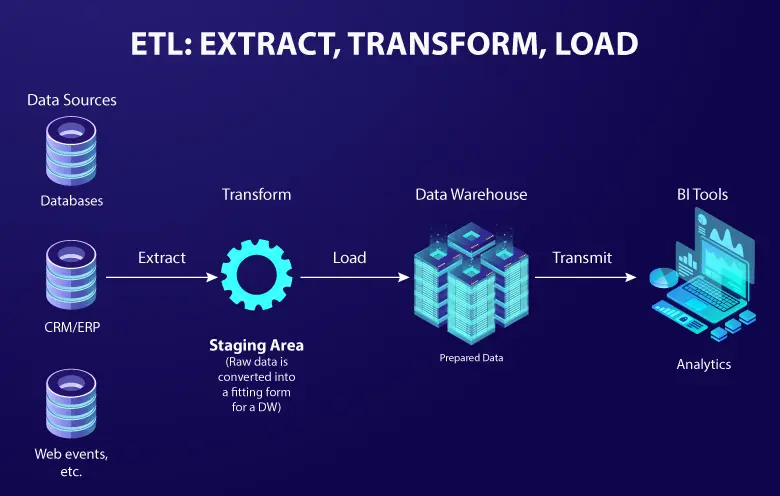In today’s data-driven world, data warehouses are a cornerstone for businesses of all sizes. However, many companies struggle to implement and manage robust data warehouse solutions. The integration and management of data warehouses bring their own set of intricate challenges, spanning issues like scalability, complexity, and performance optimization.
Here are the primary challenges in data warehouse environments:
1. Data overload: The exponential growth of data can flood traditional data warehouses. This makes manual data processing and managing vast volumes of data both challenging and costly.
2. Complex data ecosystems: Organizations often grapple with diverse data sources, formats, and structures, requiring them to integrate with intricate data ecosystems for efficient analysis.
3. Performance bottlenecks: Sluggish query responses and performance bottlenecks can lead to delayed insights, undermining a company’s ability to make timely, informed decisions.
4. Data quality and consistency: Maintaining data consistency across the organization is an ongoing challenge. Inaccurate or inconsistent data can lead to flawed analyses and decision-making.
5. Security and compliance: Safeguarding sensitive business data is paramount, with data security and evolving privacy regulations being not only a legal obligation but a business imperative.
This is where Snowflake data warehouse services come into the picture. It is an advanced cloud-based data warehouse platform that provides the key to resolving these complex challenges. In this blog, we delve into the most pressing challenges faced in data warehouse environments and unveil how Snowflake adeptly tackles them.
What is a data warehouse?
A data warehouse is a system that stores and manages data from multiple sources for reporting and analysis. It is a central repository of integrated data from one or more disparate sources and is designed to support business intelligence (BI) activities.
Data warehouses are typically used to store historical data, which can be analyzed to identify trends, patterns and relationships. This information can then be used to make better business decisions.
Data integration services, in this context, are the key enablers that ensure a seamless flow of data into the warehouse, making it readily available for analysis and decision-making.
Components of a data warehouse
A data warehouse typically consists of the following components:
- Data source: This is the source of the data that is loaded into the data warehouse. Data sources can include operational systems, such as CRM and ERP, as well as external data sources, such as social media and market research data.
- Data extraction, transformation, and loading (ETL) tools: These tools are used to extract data from the source systems, transform it into a format that is compatible with the data warehouse, and load it into the data warehouse.
- Data warehouse database: This is the database where data is stored and managed. Data warehouse databases are typically designed for high performance and scalability.
- Business intelligence (BI) tools: These tools are used to query and analyze the data in the data warehouse. BI tools can be used to create reports, dashboards, and other visualizations that help businesses understand their data and make better decisions.
How Snowflake solves data warehouse challenges effectively
Snowflake warehouse management addresses the challenges of data warehouse environments with its smart features and design. Let’s break down how Snowflake ensures top-notch performance:
- Optimal performance: Snowflake uses a smart multi-cluster shared data design, which keeps computing power separate from storage. This means it can grow limitlessly in terms of processing and power without needing tricky optimizations or manual tweaks.
- Efficient data management: Snowflake is great at handling a lot of data efficiently. It automatically optimizes and compresses data, so it doesn’t take up too much storage space while keeping performance high. Plus, it’s good at dealing with different types of data (both structured and semi-structured), making it easier to manage and boosting productivity.
- Solid security: Snowflake takes data security seriously. It has strong safeguards like data masking, encryption, and precise access controls. This means businesses can easily follow privacy rules and make sure their data stays safe and reliable.
What are the features and benefits of Snowflake for data warehousing
Now, let’s explore what makes Snowflake warehouse management an excellent choice for a data warehouse strategy. It comes with some cool features and advantages that help businesses handle their data challenges:
- Elastic scalability: Snowflake’s unique setup lets you quickly adjust to growing data and changing workloads. You can expand your data warehouse without worrying about running into hardware limits or performance issues.
- Instant flexibility: Snowflake’s flexibility means you can quickly adjust your resources based on what you need. This helps you balance performance and cost-effectiveness, making sure you use your resources efficiently.
- Automatic optimization: Snowflake uses automatic tricks like columnar storage, advanced query optimization, and smart caching. This means your queries are handled efficiently, leading to quicker responses and less resource use.
- Secure data sharing: Snowflake has secure ways to share data, even with outside parties, without risking your data’s safety. With precise access controls and strong encryption, you can confidently collaborate and put your data to work.
- Real-time data handling: Snowflake is good at dealing with real-time data. You can analyze and use data as it arrives, helping you make quick, well-informed decisions. These features and benefits make Snowflake a strong, all-in-one solution for data warehousing.
Success stories of companies using Snowflake to overcome challenges
Let’s understand how leading businesses turned their data warehouse problem and solution into a growth opportunity using Snowflake’s modern architecture. These success stories reveal real-world challenges and the strategic wins that followed.
1. Capital One: Elevating banking operations
Capital One Bank, one of the largest banks in the United States, chose Snowflake to bolster its data security and analytics capabilities. By implementing Snowflake, Capital One has unlocked valuable insights from their vast customer data, enabling well-informed decision making.
Centralizing data storage became more efficient and secure. Also, Snowflake’s data-sharing features facilitated collaboration with various teams and organizations.
2. DoorDash: Revolutionizing food delivery
DoorDash, a prominent name in the food delivery service industry, serves millions of customers, handling countless orders daily. To optimize their operations, from order placement to delivery confirmation and customer feedback, DoorDash turned to Snowflake as a robust data solution.
With Snowflake technology as part of their data infrastructure, DoorDash gained real-time data management capabilities. This transformation allowed them to enhance delivery routes and make accurate delivery time estimations. Thanks to Snowflake, DoorDash has emerged as a formidable competitor in the food delivery market.
3. Logitech: Leading innovation in the tech industry
Even in the tech sector, Snowflake has made its mark. Logitech, a global leader in the computer and gaming industry, has harnessed Snowflake’s capabilities to gain better insights into customer preferences and market trends.
Snowflake’s data analytics tools empower Logitech to analyze customer data, feedback, and market trends in real-time. This real-time analysis has elevated their decision-making, enabling the company to develop products tailored to their target audience’s preferences. The result has been a rapid increase in sales and Logitech’s continued success.
4. Instacart: Pioneering grocery delivery
Instacart, a leading name in online grocery delivery and pickup services, found Snowflake to be an invaluable ally, especially during the challenging times of the COVID-19 pandemic. Snowflake played a crucial role in helping Instacart manage a surge in orders and deliver them within the promised time slots.
Snowflake’s scalability features support their data infrastructure to meet increased customer demand. The tool’s data-sharing capabilities streamline collaboration between teams, organizations, and customers. This, in turn, builds trust and satisfaction among customers, leading to Instacart’s success.
These real-life success stories demonstrate that Snowflake isn’t limited to a specific industry; its impact extends across various sectors. Companies ranging from food delivery to banking, grocery delivery and tech have all found Snowflake to be an invaluable asset in achieving their goals.
AI-powered data warehousing made easy
Why choose Softweb for Snowflake data warehousing solutions
At Softweb Solutions, our collaboration with Snowflake unlocks the full potential of your data, making data warehousing challenges effortless to overcome. We provide the expertise needed to streamline operations, enhance security and drive growth.
With real-life success stories as proof, Snowflake data warehouse services emerge as the ultimate solution for your data warehousing needs, addressing challenges like managing increasing data volumes, ensuring secure data sharing, and enabling real-time data processing.
If you are seeking a robust data warehousing solution for your traditional data warehouse environment, Snowflake is the ideal choice. Contact our experts today to embark on a data-driven journey tailored to your business needs.
FAQs
1. How is Snowflake different from other data warehouses?
Snowflake data warehouse differentiates itself from traditional data warehouses by offering a fully managed, cloud-native, and pay-as-you-go platform. It eliminates the need for hardware infrastructure, setup, or maintenance unlike, on-premises solutions allowing users to focus on data analysis.
2. What is the competitive advantage of Snowflake?
The competitive advantage of Snowflake includes multi-cloud architecture, cost-effectiveness, scalability, and ease of management. Its independent architecture lets you scale compute and storage independently, reducing costs and enhancing performance.
3. Is Snowflake a data warehouse or ETL?
Snowflake technology is a cloud-based data warehouse. While it can be used in conjunction with ETL (Extract, Transform, Load) processes, it is not an ETL tool itself. Snowflake offers a platform to store and analyze data, and data can be ingested using various methods, including ETL and ELT.
4. What are the pitfalls of a data warehouse?
While data warehouses offer numerous advantages, there are a few disadvantages like high initial and ongoing costs, complexity in setup and administration, the potential for slow query times due to large data volumes, and the need for skilled engineers.
Our Snowfalke experts can navigate you through these pitfalls, by modernizing your data platform, breaking down data silos, and ensuring scalable, secure, and unified data management for enhanced business insights. Contact us today.




